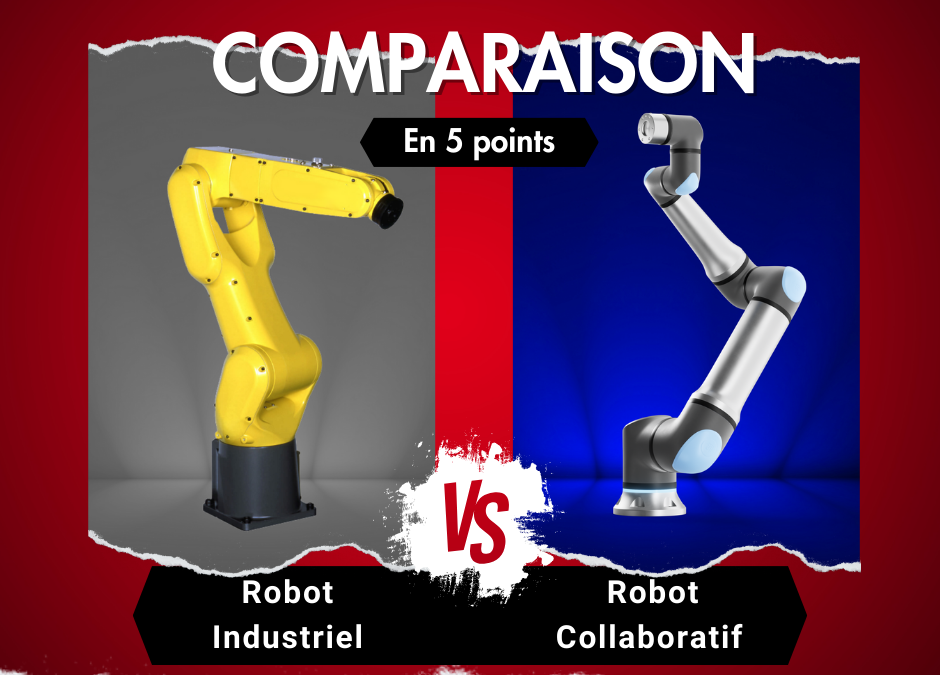Distinguish between industrial and collaborative robots.
In the world of industrial automation, the distinction between industrial robots and collaborative robots (cobots) has become a crucial topic of discussion for companies seeking to optimize their production. While industrial robots have long been the cornerstone of automated manufacturing, the emergence of cobots has opened up new avenues for the integration of robotics in a variety of work environments.
This comparison aims to shed light on the distinctive features, benefits and limitations of each type of robot, offering valuable insight for decision-makers and engineers considering the integration of robotic solutions into their operations.
By examining key aspects such as load capacity, flexibility, safety, cost and integration, we can better understand how industrial robots and cobots fit into the modern automation ecosystem, and how they can be optimally used to meet the specific needs of each company.
1- Load capacity and power:
- Industrial robots: These robots are designed for demanding tasks. They can lift loads ranging from a few kilograms to several tons. Their robust structure and powerful motor systems enable them to perform tasks at high speed and with millimetric precision, which is crucial in sectors such as the automotive and metalworking industries.
- Collaborative robots (Cobots): Cobots are generally limited to lighter loads, typically less than 10 kg. This limitation is due to the fact that they are designed to guarantee the safety of human workers. They are ideal for tasks such as assembling small components, packaging, or handling delicate products.
2- Flexibility and adaptability:
- Industrial robots: Although they are extremely efficient in their programmed tasks, they lack flexibility. Changing the task of an industrial robot can require complex reprogramming and sometimes retooling, which can be costly and time-consuming.
- Collaborative robots: They are distinguished by their ease of programming and reconfiguration. Even employees with no programming experience can often reprogram them for new tasks, making them ideal for production environments that regularly change products or processes.
3- Safety and Working Environment:
- Robots Industriels : Their power and speed require strict safety measures. They are often isolated from human workers to avoid accidents, which can limit the flexibility of plant layout.
- Collaborative robots They are designed to detect human presence and react accordingly, either by slowing down or stopping completely. This feature enables smoother integration into shared workspaces, increasing flexibility and production efficiency.
4- Cost and ROI (Return on Investment ) :
- Industrial robots: Initial investment can be high, not only because of the cost of the robot itself, but also because of additional expenses for safety and infrastructure. However, for large-scale, continuous operations, they can offer a very favorable ROI over the long term.
- Collaborative robots: Their lower initial cost and ease of integration make them attractive to small and medium-sized businesses. Their flexibility enables companies to use them for different tasks, which can accelerate ROI.
5- Integration and Implementation:
- Industrial robots: Implementing them can require a significant overhaul of the production line, as well as specialized training for operators. This can represent a significant investment in terms of time and resources.
- Collaborative robots: These are often "ready-to-use", and can be integrated into existing production environments without major modifications. Their intuitive programming and flexibility enable rapid implementation and easy adaptation to changing needs.
In conclusion, the choice between an industrial robot and a collaborative robot largely depends on the specific needs of the application, the type of production, the size of the company, and the long-term objectives in terms of production and efficiency.
Industrial robots are best suited to large-scale, repetitive, heavy-duty tasks, while collaborative robots excel in flexible, changing production environments, working in close collaboration with humans.
Do you have any questions?

